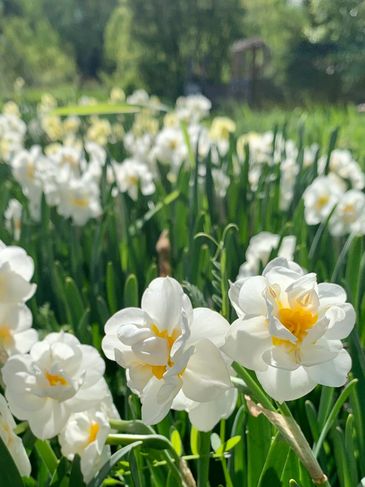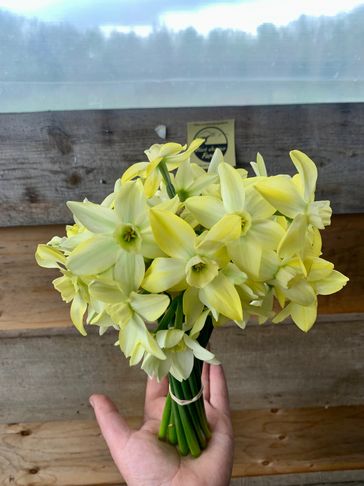2025 fall Bulb Assortment

Poetaz Narcissus ( Double )
Poetaz Narcissus ( Double )
Poetaz Narcissus ( Double )
Each stem produces 3-5 creamy white and tangerine flowers with a wonderful sweet floral fragrance. Excellent for naturalizing.
Height: 14-16"
Zone: 3
Fragrant: Yes
Bloom time: Mid-Late spring

Muscari
Poetaz Narcissus ( Double )
Poetaz Narcissus ( Double )
Super cute and easy to grow.
Stems bare dense clusters of dark purple flowers with a sweet, candy-like fragrance. A favorite spring snack for early bees. Excellent for containers, raised beds or smaller garden areas
Height: 6-8"
Zone: 3
Fragrant: yes
Bloom time: Early spring

Rock garden Narcissus
Poetaz Narcissus ( Double )
Darwin tulip mix ( "Mr. butter & Mrs. Blush ")
One of the earliest and most fragrant narcissus we've come across. Produces multiple blooms per stem. Apple green blooms slowly fade to crisp white with a honeydew cup.
Height: 10-12"
Zone 3
Fragrant: Yes
Bloom time: Early spring

Darwin tulip mix ( "Mr. butter & Mrs. Blush ")
Darwin tulip mix ( "Mr. butter & Mrs. Blush ")
Darwin tulip mix ( "Mr. butter & Mrs. Blush ")
Stunning combination of blush and butter yellow blooms on very tall, sturdy stems. Yellow tulips have striking variegated foliage for added garden interest. Great for larger landscapes and mixed bulb plantings.
Height: 20-24"
Zone: 3
Fragrant: Slightly
Bloom time: Late spring

Poetaz Narcissus ( single )
Darwin tulip mix ( "Mr. butter & Mrs. Blush ")
Poetaz Narcissus ( single )
Each stem produces multiple, crisp white flowers with a tangerine cup. Wonderful sweet floral fragrance. Excellent for naturalizing.
Height: 14"
Zone: 3
Fragrant: Yes
Bloom time: Mid-Late spring
FAll bulb planting guide

Sun + soil
Sun: Most bulbs love full sun (6+ hrs/day).
Soil: Well-draining soil is key to healthy, long lasting bulbs. If the soil stays soggy... your bulbs will rot. You can improve heavy soil with compost or sand, or use raised beds with well a draining soil mix.
Depth + Spacing
Depth: As a general rule of thumb, plant bulbs about 2–3 times as deep as the bulb is tall.
Poetaz Narcissus : 4-6" deep
Muscari: 2-4" deep
Tulips: 5-6" deep
Spacing: Leave room for bulbs to multiply over the years and allow airflow between plants to reduce disease.
. small bulbs (2–4" apart),
large bulbs (4–6" apart).
Fertility and other tips
Fertilizer: You can add a small amount of bulb fertilizer or compost at planting time but be careful not to overdue it. Excessive fertilizer can burn the newly formed roots.
Label: Mark spots so you don’t dig them up later! ( Small dowels or painted rocks work very well )
Continuing care... Once plants have finished blooming in the spring, you can remove seeds pods or spent blooms, but DO NOT be tempted removed the greenery. Instead, allow the plant to completely die back naturally.